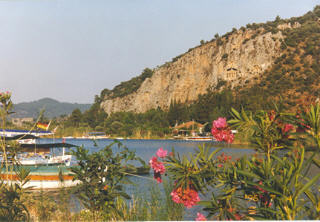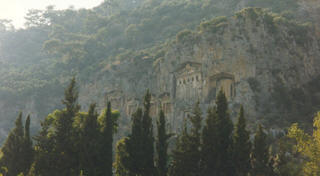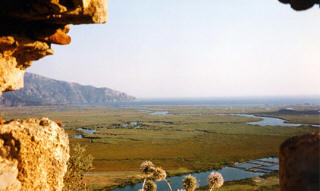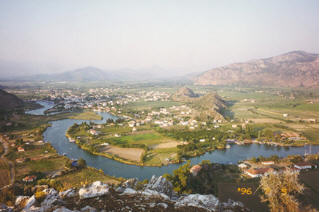

Hidden in a corner of southwest Anatolia where the Aegean meets the Mediterranean and the Golgeli Daglari swoops down to the sea, the estuarine delta of the Dalyan River supports a number of small fishing and farming communities as well as a nature and wildlife sanctuary. It is noted for its ancient Caunian ruins and the 4th Century BC Lycian-style temple-tombs carved into the cliffs above the river but one must linger long enough to discover its many opportunities for adventure.
 |
Dalyan |
Your first exploration of the Dalyan area should be a visit to the ruins of Caunos. It was an independent city state that is thought to have been founded by Caunos, son of Miletos. Herodotus characterizes Caunians as a distinct people who emigrated from Crete in the late Minoan era. Eventually, they assimilated the language of the neighboring Carians and adopted the funerary customs of both the Carians and the Lycians whose kingdoms were roughly bordered by the waterway now known as the Dalyan River. Subsequent conquests have resulted in mixed ruins that include 4th Century BC walls built by King Mausolus of Caria, a Roman bath and a Byzantine basilica. The silting of the ancient harbor brought an end to the affluence of Caunos which was dependent on the export of salt, fish and slaves while rivaling Ephesus as a wealthy seaport. Eventually the city was abandoned. The theater offers a good view of the ruins but the citadel, high on the hill beyond the old defensive walls, commands a sweeping panorama of the countryside.
Directly to the north, Lake Koycegiz is obscured by the pine clad precipice that overhangs the river. Cultivated fields extend from the base of the citadel to the cliffs where Carian style tombs at the lower levels give way to the Lycian style tombs carved higher into the rock.
 |
Lycian Tombs |
There are excellent views to the south where the river meanders through the marshy delta to meet the Mediterranean Sea at Iztuzu beach, a nesting place for the endangered loggerhead sea turtle (Caretta caretta). Great clumps of reeds line the river and its distributaries and provide refuge to waterfowls and other birds. Mullet and sea bass are plentiful and are an integral part of the area's economy.
 |
Dalyan Delta With Fishing Weirs Across The River |
In the distance, gulets ply their way along the coastline exploring Turkey's numerous coves and inlets that are often inaccessible by land. The famed Blue Voyage extends from Izmir to Antalya but most visitors prefer a shortened version. Traditionally fishing boats, gulets are now designed with every convenience for visitors and tours can be arranged for whatever period you may desire. A cruise that takes in any portion of the Blue Voyage is highly recommended. If your time is limited, then consider a two day cruise or the one day, 12 island tour in the Gulf of Fethiye. There are ruins to explore, secluded beaches, fantastic scenery and turquoise water.
The eastern and northeastern vista captures the river winding its way through the town of Dalyan towards Lake Koycegiz and the foothills of the Boga Dagi. Cotton, corn and vegetables grow in neat rows especially along the river banks where water can be diverted for irrigation while greenhouses seem to overflow with tomatoes, eggplants and peppers. There is a charm to the rural life of Dalyan that continues unfazed in spite of the demands of tourism. Farmers have a welcoming smile for visitors and will generously take the time to show them around and to point out the special type of grass that is used to feed the ostriches that are being raised experimentally in the area. In the summertime, dawn arrives early for these hard working people and they take advantage of the cooler mornings before the onslaught of the midday sun. Women usually tend the larger fields as hired hands while entire families work their smaller family plots. They will have been at work for hours before the town begins to stir.
 |
The Dalyan River |
Lake Koycegiz is most popular for the mud baths along its southern shore. They are prescribed for those suffering from rheumatic, dermatological and gynecological problems as well as physical exhaustion. Treatment consists of covering yourself with a layer of mud and then soaking in the adjacent hot, mineral water pool. Regardless of your afflictions or lack of them, it is irrefutable that this is a most relaxing way to end a busy summer day. There are boat tours to the mud baths on Lake Koycegiz but those who want to soak in solitude should ask about the small mud bath on a canal by the river that can be reached only be kayaks or canoes.
With its thick reeds, Lake Koycegiz provides a rich spawning ground for mullet and sea bass. It is a part of the wildlife sanctuary that follows the river through the marshlands to Iztuzu Beach. Many species of birds have been sighted here including herons, cranes, kestrels, storks, egrets, kingfishers and less frequently, the endangered sea eagle. It is this tranquil scenery and natural beauty that frames the lakeside village of Koycegiz on the northern shore. Monday is the busiest day when local farmers set up their weekly open air market. Besides a cornucopia of fresh fruits and vegetables, there is usually a good selection of dried fruits, honey and unusual spices. The spacious promenade along the lakeshore is ideal for a leisurely stroll and there are benches and tea gardens for those who want to linger. Boats can be hired to explore the lake or to visit Old Koycegiz which was abandoned in 1867 due to persistent flooding. It sits on the northern bank of the Yuvarlak stream nearby. A few families have remained and there are some old buildings from Ottoman times.
Just beyond Koycegiz to the north, a secondary asphalt road gives way to a dirt road that climbs the Boga Dagi to the high plateau village (yayla) of Agla. Shepherds still accompany their flocks along centuries old paths to these mountain pastures in the springtime. The remaining families now travel by motorized vehicles to the village where permanent housing, electricity and well stocked stores have reduced the need for the goat haired tents and provisions that were once required for the annual transhumance. The cool mountain air of Agla attracts those who want to escape the fierce summer heat and to enjoy the Mahya Festivities that are held on the first Thursday following the 13th of August.
From Agla, there is a very scenic,18 km trek through pine forests to the yayla at Cicekbaba, the highest point (2295m) in the Sandras Dagi. There are no facilities at Cicekbaba so trekkers must be prepared to carry a full pack. For the
 |
Old Roman Bridge |
All roads to Dalyan will take you past the fragrant "frankincense tree," (Liquidambar orientalis). These trees are unique to southwestern Anatolia and a large forest is located along the way to Hamitkoy, a small village to the west of Koycegiz. Although it was botanically unknown in the west until the mid 19th century, its oil has been long prized in the east for medicinal and cosmetic purposes and is reputed to be the "balm of Gilead." Liquid storax has been exported since ancient times to China, India and the Middle East. Its extraction is carried out mainly by Yoruks, a nomadic tribe of eastern Anatolia. The young wood of the tree is injured to cause the formation of oil ducts in which the storax is produced. Strips of the inner bark are then removed for pressing. Many of the trees exhibit scars to the trunk and it is a part of this traditional skill to know how much damage can be inflicted without killing the tree. Today, the government is sponsoring reforestation projects to replace the frankincense trees that were once so plentiful in the region.
Best Times to Go:
In southwest Anatolia, the tourist season lasts from the
beginning of April to the end of October. However, April to mid June and September to
October are the best months for avoiding the intense heat, summer crowds and mosquitoes.
Getting There:
Turkey has excellent bus and minibus service and Dalyan is easily
reached from the cities and towns of the Aegean and the Mediterranean.
The nearest Greek ferry arrives in Marmaris from Rhodes. There are buses from Marmaris to Dalyan but for a group of at least four, it is more convenient to take a taxi directly from the docks. The total cost will be similar while eliminating the trip to the bus station in town and waiting for the next bus.
The closest airport is located in Dalaman, about 22 km away. Regular buses or taxis are available to Dalyan. Turkish Airlines (THY) flies to Dalaman from Istanbul and Ankara. Some international flights arrive directly in Dalaman from Europe.
Clothing/Gear:
Casual, warm-weather clothes are suggested for Dalyan during the
summer season. Water sporting equipment is readily available for rent. Be sure to bring a
wide brimmed hat, sun tan lotion, mosquito repellent and comfortable shoes.
When traveling in Turkey, it is a good idea for women to bring a long skirt, light sweater and pretty shawl. They can quickly be slipped on over casual clothes to dress up for dinner or to become appropriately dressed when visiting the mosques.
General Information:
If you plan to visit other areas of Turkey, consider flying
since distances are so great between the different areas of interest. Turkish Airlines
offers coupons for national flights in conjunction with their airline tickets from the US
and Europe. These coupons are excellent bargains that cost $70-$100 per leg. Bus travel
within Turkey is easy and inexpensive.
Boats are the preferred way to get around Dalyan. The boats that line the town's pier all belong to the Dalyan Kooperatifi and fares are regulated. There is no bargaining unless there are many idle boats. The boat tours are a good value but they operate on a schedule that may not meet your needs. Hotels and pensions by the river often have their own boats that offer regular trips into town and customized tours. Some provide rowboats for their guests.
Hotel and pension prices are regulated in Dalyan. There is a classification system that determines the price but we found quite a wide discrepancy in comfort and quality among facilities with similar prices. We strongly recommend that you check out your options before selecting your accommodations. The newer hotels are located to the north along the unpaved portion of Gulpinar Sok adjacent to the Melody Restaurant.
Dalyan is still a bargain for visitors. Food and comfortable lodging cost $30-50 per person per day. Camping and the use of pensions will reduce this amount considerably. There are many opportunities for exploring on your own but specialized tours such as diving and rafting will cost about $65-90 per person. Local rental cars cost about $55 per day and mountain bikes may be rented for about $8 per day.
Planning Tips
:Important Resources:
Kaunos Tours is owned and operated by Mr. Mehmet Cobanoglu, a friendly and sincere
outdoors enthusiast with extensive local knowledge of the Dalyan area. Besides renting
cars, motorcycles, mountain bikes and tents, Mr. Cobanoglu provides some of the best
hand-detailed maps of the town of Dalyan and the surrounding areas around Lake Koycegiz.
He is an avid cyclist who has personally measured the distances along all the paved and
unpaved roads and knows the most scenic routes in the area. On the town map he identifies
the local places that would be of interest to visitors: hotels and pensions, post office
(PTT), banks, pharmacy, hospital, restaurants etc. Mr. Cobanoglu will help you with just a
day trip or in planning a lengthier adventure in Southwest Anatolia. He has some excellent
values for accommodations and food and an extensive list of sightseeing excursions that
include river kayaking, rafting, exploring canyons, trekking, jeep or horse safaris, Blue
Voyage tours, numerous cycling itineraries, and the usual sightseeing tours. Assuming
double occupancy, an all inclusive seven day adventure starts at about $550 per person.
Alternatif Outdoor specializes in rafting and kayaking trips as well as other outdoor activities in Southwest Turkey amd Cappadocia. It is the longest established and most experienced outdoor activity company in Turkey. The owners have many years’ experience as professional river and outdoor guides, and their active involvement in the business includes frequent guiding. As a result they take a personal interest in each tour, ensuring that the quality of service and attention to detail remains high.
Related Books © copyright 1996-2003 Adventures Great and Small
PTT Karsisi 48840
Dalyan-MUGLA-TURKIYE
Tel: 0-252-284-28-16
Fax: 0-252-284-31-57
Email: kaunos@email.com
Kenan Evren Bulvari, Camlik sok. 10/1
48700 Marmaris-Mugla-TURKEY
Tel: 90-252-417-2720
Fax: 90-252-417-3952
Email: info@alternatifraft.com
